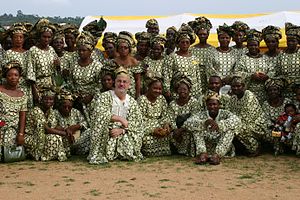

Asọ-Ẹbí (Yoruba), sometimes spelt as Asọẹbí in Nigeria is a uniform dress or dressing code/style that is traditionally worn by the Yoruba People is an indicator of cooperation, camaraderie and solidarity during ceremonies, events and festive periods. The purpose of wearing the dress can be to serve as self-identification with age mates, relatives or friends during social occasions or funerals.
Origins
The word Aṣo in Yoruba means cloth and Ẹbí denotes family group. Asọ-Ẹbí can be described as a family dress code usually worn in uniforms during family ceremonies such as weddings, funerals, birthdays & anniversaries. The practice has now spread beyond family dressing because well-wishers of a celebrant can wear the Asọ-Ẹbí. Asọ-Ẹbí is also acculturated by other ethnic groups in Nigeria, especially in the South East and South-South of Nigeria due to its colorful culture and popularity as well.
Ayodele Olukoju, a Nigerian economic historian, believes Asọ-Ẹbí became a novelty in 1920 during a period of post-World War I economic boom triggered by the higher prices for products such as oil palm. William Bascom traced the origin to an earlier period when members of Yoruba age grade wore uniform dress to mark fraternal bonds. In the 1950s, members of women's organizations or egbes turned out to ceremonies and anniversaries of relatives in the same style of dress, sandals, lappa, smock, or necklace; the culture signifies close friendship. The uniform dressing can also be a measure of personal affluence because aso ebi involves rivalry between various egbes or groups with each group competing to outshine each other in terms of quality, originality and richness of the uniform.
1960s and beyond
From the mid-1960s to the late 1970s, imported lace and george were incorporated into Nigerian fabrics and they became popular items used for aso ebi. Increased demand for handcrafted traditional dresses such as agbada led to a resurgence of tailors and fashion designers specializing in making native attires. The tailors strived to meet the increasing demand and designs of uniform dressing, sometimes with the aid of the fashion pages of magazines to make style choices. The rise of aso ebi also coincided with an intense market of fashion and lifestyle magazines in Lagos; tailors look at designs for inspiration and their patrons buy the magazines to see whether they or their friends are pictured in them. Okechukwu Nwafor has shown how aso ebi is a consequence of Lagos cosmopolitanism whereby its fashioning is largely tied to a dialogue between photographers, fashion magazines, vendors, and tailors in urban Lagos. In recent times, the extent of social expansiveness that has befallen aso ebi is such that both a stranger and an uninvited guest might seek recognition through aso ebi. The increasing eagerness of guests to don aso ebi stems from the special recognition bestowed upon those who do. This underscores the notion that at most social gatherings in Nigeria, aso ebi is held in higher regard than anything else, even the food.
Aso ebi in recent times has become a city phenomenon that has spread to other West African cultures. For example, in Sierra Leone and Cameroon aso ebi is rephrased as Ashobi with many participants unaware of its Yoruba origins. Dealers of imported and local textile materials have benefited from the boom in demand for uniform dressing. Some textile dealers offer consultation services and bulk rates for the choice and cost of the dress and fabrics. While the price of fabrics in sewing the traditional attire is affordable, the aso ebi practice is still sometimes used as an identification with affluence. Some wear expensive embroidery and extra layers of cloth, whereas others, who cannot afford a whole outfit, add only matching tops and head coverings. Aso ebi has become an attire of class worn by celebrities and elites in recent times, especially Nigerian Nollywood stars. With fashion designers creatively making outfits for special occasions to meet the taste of their wealthy customers, aso ebi outfits have become a regular occurrence today.
References
- "Special occasions in Sierra Leone are often marked by the wearing of "ashobie." Ashobie means "uniform" in Krio". 8 October 2021.
- "This Thing About 'Ashobies'". 8 October 2021.
- ^ Olukoju, A. (1992). "Maritime Trade in Lagos in the Aftermath of the First World War". African Economic History. 20 (20): 119–135. doi:10.2307/3601633. JSTOR 3601633. S2CID 152774038.
- ^ Nwafor, Okechukwu (2011). "The spectacle of Asọ-Ẹbí in Lagos, 1990–2008". Postcolonial Studies. 14 (1): 45–62. doi:10.1080/13688790.2011.542114. S2CID 143039242.
- O.A. Ajani (2012). "Aso Ebi: The Dynamics of Fashion and Cultural Commodification in Nigeria" (PDF). The Journal of Pan African Studies. 5 (6): 108–18. Archived from the original (PDF) on December 29, 2017.
- Little, Kenneth. (1974). African Women in Towns: An Aspect of Africa's Social Revolution. Cambridge University Press. P. 142
- Nwafor, Okechukwu (2015). "Of Mutuality and Copying : Fashioning Aso Ebi through Fashion Magazines in Lagos". Fashion Theory. 16 (4): 493–520. doi:10.2752/175174112X13427906403840. ISSN 1362-704X.
- Yaakugh, Kumashe. "African Fashion: 9 Ladies Command Attention in Head-Turning Asoebi Styles".
- Nwafor, Okechukwu (2021). Aso Ebi: Dress, Fashion, Visual Culture, and Urban Cosmopolitanism in West Africa. Ann Arbor: University of Michigan Press. ISBN 978-0-472-05480-0.
- Nwafor, Okechukwu (2015). "Of Mutuality and Copying : Fashioning Aso Ebi through Fashion Magazines in Lagos". Fashion Theory. 16 (4): 493–520. doi:10.2752/175174112X13427906403840. ISSN 1362-704X.
- Nwafor, Okechukwu (2013). "The Fabric of Friendship: Aso · Ebì and the Moral Economy of Amity in Nigeria". African Studies. 72 (1): 1–18. doi:10.1080/00020184.2013.776195. ISSN 0002-0184.